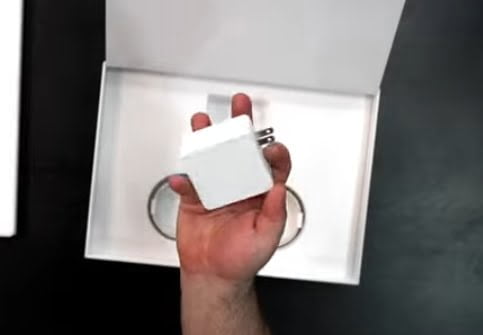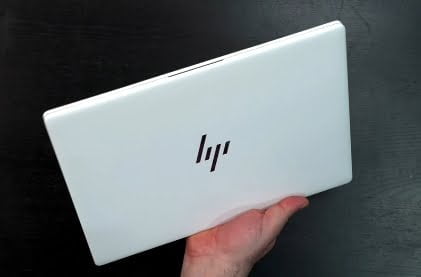he HP Dragonfly Pro, a laptop born from HP’s close collaboration with AMD. Together, they’ve crafted a seamless user experience. Powered by the AMD Ryzen 7-736 processor, boasting 8 cores and 16 threads, it delivers impressive performance. The laptop features a stunning Full HD Plus display and is available in two attractive colors: ceramic white and sparkling black. Both colors are visually appealing.
With great battery life and efficient processing, the HP Dragonfly Pro excels in overall performance.
Specifications
| Operating System | Windows 11 Home(1) |
| Screen Size | 14″ |
| Battery | UP to 15 Hours (2) |
| Weight | 3.42lbs (4) |
| Touchscreen | Standard |
| Web Camera | 5MP |
| Audio | Quad Speakers |
| Support | 24/7 Pro live Support (5) |
| Price | $1,54 |
Unboxing and Design



Inside the box first off, we have the HP Dragonfly Pro itself, which feels pretty sleek. Then, there’s the power brick – it’s a 96-watt one with flip-out prongs, providing a good charging rate, especially since there’s no separate GPU. I gotta say, the braided cable they include looks really sharp, especially in this white color. It’s stunning! Now, in terms of weight, it comes in at 1.547 kilograms or 3.66 pounds. It’s a bit chunkier than some 14-inch laptops, but it feels premium and high-end.


On the left side, you’ve got two USB Type-C Thunderbolt 4 ports that do it all – they handle data, charging, and display output. Now, on the right side, there’s another USB Type-C port, but it’s not Thunderbolt; it’s USB 3.2 Gen 2 speed. Still, it’s full-featured, just like the Thunderbolt ones. But wait, there’s something missing – no headphone jack! So, if you’re using wired headphones, you’ll need an adapter or go Bluetooth. No USB-A port or HDMI either, but those two Thunderbolt 4 ports and the USB-C port cover your connectivity needs.
Display and Audio Quality

The HP Dragonfly Pro features a Full HD Plus resolution of 1920 by 1200 pixels with an IPS panel, not OLED or other advanced technologies. The touch-enabled display performs exceptionally well, boasting a claimed brightness of 400 nits, which my tests confirmed exceeded expectations. However, compared to the Chromebook’s super bright 1200-nit display, it falls slightly short. Nonetheless, the Dragonfly Pro’s display remains impressive.
The refresh rate is locked at 60Hz without options for higher rates or resolutions like 4K Plus or QHD Plus. Despite this limitation, the Full HD Plus display excels with deep blacks, vibrant colors, and accurate color reproduction—ideal for creative tasks such as using Lightroom, Photoshop, or video editing.
With its glossy finish, the display may reflect light in certain conditions, though this isn’t overly distracting. Streaming services like Netflix, Amazon, or YouTube deliver an enjoyable viewing experience. Overall, it’s an excellent display for daily use, supporting multi-touch for navigating the OS but lacking stylus support. While a QHD Plus option akin to the Chromebook would be appreciated, this display stands strong on its own merits.
In terms of audio, the HP Dragonfly Pro impresses with rich, well-tuned speakers. Comparing them to the top-tier speakers of the MacBook Pro 14, the Dragonfly Pro may fall slightly short in sound quality. However, among Windows laptops, it offers notably good audio performance.
Webcam and Fingerprint Reader
Unlike previous business-focused models, this version also targets consumers and freelancers. The camera performs well, offering 1440p resolution at 30 frames per second, which is impressive. How effective are the array microphones at reducing background noise? Is the audio clear to you? Share your thoughts in the comments.
The camera includes infrared (IR) technology for face recognition login via Windows Hello. Additionally, a fingerprint scanner is integrated into the keyboard. I appreciate the camera controls available in the My HP app. These include auto framing, portrait, tight shot, and wide shot modes. Auto framing, though not new, remains useful. You can adjust background blur intensity and choose settings like cafe or outdoors. Custom background images are also supported.
The app offers appearance enhancements. You can adjust effect intensity, choose natural skin tones, and optimize for backlight and low-light conditions. What are your thoughts on these features of the Dragonfly Pro? Let me know in the comments. In my experience, the camera performs exceptionally well.
Keyboard and Haptic Touchpad

Opening with just one finger is smooth. Now, onto the keyboard—HP deserves credit for doing an excellent job here. Key travel, feedback, and actuation are all spot-on. It’s one of the best keyboards you’ll find on a 14-inch clamshell. The multi-stage backlight functions well. Keep in mind, with the ceramic white color, the white LED backlight on these keys can be hard to see. This isn’t an issue with sparkling black. Overall, the keyboard has been impressive.
Moving to the touchpad—it’s a haptic touchpad and very responsive. Two-finger scrolling works smoothly, and all gestures are accurate. The haptic engine is finely tuned, delivering excellent responsiveness throughout my use. In summary, it’s a standout feature of this laptop.
User Upgradeability

This laptop doesn’t allow you to upgrade components yourself. Everything, including the CPU, Wi-Fi, and SSD, is soldered onto the motherboard. Even the RAM isn’t user-upgradable, similar to MacBooks. This means you can’t swap out parts like the SSD or RAM. If you’re considering upgrades, you’re out of luck.
Regarding storage, my review unit has a fast 512GB PCIe Gen 4 SSD, which provides quick read and write speeds, as demonstrated by these results.
Performance
| Laptop | CINEBENCH R20 | CINEBENCH R23 (Single Core) | CINEBENCH R23 (Multi-Core) | 3DMARK Time Spy/Fire Strike |
|---|---|---|---|---|
| HP Dragonfly Pro | 4805 | 1544 | 10,610 | 2828/6,494 |
| Galaxy Book 3 Pro | 3328 | 1683 | 7869 | 1689,4,198 |
The HP Dragonfly Pro is powered by AMD’s Ryzen 7 7000 series processor, specifically the Ryzen 7 736. This processor packs 8 cores and 16 threads and is built on a 6-nanometer chipset.
The Ryzen 7 736 in the HP Dragonfly Pro delivers impressive performance, not only offering excellent CPU power but also shining with its integrated Radeon graphics, the 680m. AMD’s integrated graphics outperform Intel’s Iris XE Graphics, showcasing AMD’s strength in graphics performance. This translates to better performance in gaming, video editing, and graphics-intensive tasks.
In everyday use, such as running Microsoft Office and web browsing, the HP Dragonfly Pro handles smoothly without any slowdowns. Its performance in both single-core and multi-core tasks is commendable, as evidenced by strong Cinebench R23 scores.
Overall, AMD’s Ryzen processor proves itself as a solid contender in the market, excelling in both CPU power and integrated graphics performance.
Fan Noise and Surface Temps
During stress testing with the Time Spy test, the laptop scored 95.4, indicating throttling to maintain lower temperatures, which is typical for thin laptops. Surface temperatures generally remained cool, with occasional warm areas that never reached uncomfortable levels.
The laptop’s two fans operated quietly and effectively kept temperatures cool, even under heavy loads, demonstrating efficient thermal management. HP and AMD collaborated closely on performance and thermals, optimizing background processes for a smooth user experience.
For average users, settings are pre-optimized without requiring manual adjustments. Power users have access to the AMD performance app, offering detailed control and customization options.
AI-driven learning enhances performance optimization, showcasing the fruitful collaboration between AMD and HP in improving user experience and system efficiency.
Battery Life
| Laptop | PCMark 10 Modern Office | PCMARK 10 MS Office | PCMARK 10 Video Playback | PCMARK 10 Gaming |
|---|---|---|---|---|
| HP Dragonfly Pro 65Wh | 13h54m | 11h55m | 14h00m | 1h53m |
| Lenovo Yoga 9i Gen 8 75Wh 2.8k OLED 90Hz | 11h40m | 10h49m | 11h01m | 1h29m |
| Samsung Galaxy Book 3 Pro 63Wh | 7h58m | 9h32m | 9h27m | 1h59m |
HP Dragonfly Pro stands out for its great battery life, thanks to its efficient 65.5 watt-hour battery. AMD’s processor not only packs power but also efficiency, resulting in impressive battery performance.
During the Modern Office test in the PCMark 10 battery test, the laptop ran for an impressive 13 hours and 54 minutes. It outperforms competitors like the Yoga 9i and Samsung Galaxy Book 3 Pro, both with Intel’s 13th generation P series processors. Overall, this laptop excels in battery life, thanks to AMD’s focus on efficiency.
If you need to charge up, the included 96-watt power charger fully charges the laptop in about an hour and 10 minutes. This fast charging ensures minimal downtime when you need to power up.
24/7 Support
HP has emphasized the convenience of Dragonfly Pro’s 24/7 support accessible with a dedicated keyboard button. This feature is indeed functional: pressing the button opens the my HP app, facilitating live chat or call support with an agent.
The service is priced at $10 monthly, but HP offers 12 months free upon purchasing an HP Dragonfly Pro or HP Dragonfly Pro Chromebook. Some users may find the button’s keyboard space allocation a drawback. It remains to be seen if customization options for the button’s function will be available. Nonetheless, for users valuing quick and accessible support, this feature proves highly beneficial.
Final Thought
The HP Dragonfly Pro, launched in 2023, showcases a successful collaboration between HP and AMD. Featuring a bright and sharp Full HD Plus touchscreen display, available in ceramic white or sparkling black, it exudes a premium and classy look. The AMD Ryzen 7 7736U processor not only enhances battery life but also ensures the laptop remains cool and quiet during use.
The Bang & Olufsen tuned quad speakers deliver decent audio quality, although they fall short of the exceptional sound of the MacBook Pro 14’s speakers. Two Thunderbolt 4 ports provide versatile connectivity options. The keyboard and haptic touchpad offer a satisfying tactile experience.
The 1080p webcam performs adequately, and the Radeon graphics surpass Intel’s integrated Iris XE Graphics, marking a significant performance advantage. However, the laptop lacks a headphone jack and features like upgradable RAM, SSD, or Wi-Fi, as they are soldered in. Additionally, there’s no SD card slot, HDMI port, high refresh rate option, or choice for UHD Plus or OLED displays.
Nevertheless, the Full HD Plus IPS display remains impressive. Despite these limitations, the HP Dragonfly Pro stands out as a solid laptop with powerful performance, a stylish design, long-lasting battery, and impressive audio capabilities. It presents a compelling option despite some drawbacks and missing features.
The HP Dragonfly Pro 2023 impresses with its partnership between HP and AMD, resulting in a sleek design and powerful performance. The bright full HD Plus touchscreen display, stylish design options, and excellent battery life make it a standout choice. While it lacks certain features like a headphone jack and upgradability options, its overall performance and audio quality still make it a solid option for users looking for a reliable laptop.
- Design10
- Hardware10
- Display9
- Performance9
- Thermals/Fan Noise8
- Battery10
- Keyboard9
- Touchpad10
- Wb Cam/Mic9
- Ports7
- Audio9
- Price8

